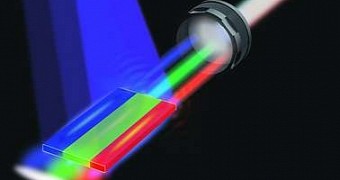Although lasers aren't a completely new thing in modern science, one single and seemingly simple feat has never been achieved, to create white lasers.
Since their invention in 1960 no one has managed to create white lasers. Although being used in thousands of applications, no laser is white but mostly limited to green, red or blue depending on each application. In order to create a white laser, RGB-colored beams should emit the full visible color spectrum, which they don't by default.
The researchers of Arizona State University, however, have solved this mystery by proving that semiconductor lasers can emit such full spectrum-colored beams and build white lasers. The scientists created a novel nanosheet, a thin layer of semiconductor that measures just about one fifth of the thickness of human hair in size by a thickness that's roughly one-thousandth of the thickness of a human hair, with three parallel segments supporting laser action in one of the three elementary colors. The device can lase-in any visible color, entirely tunable from red, green to blue, or any color in between, and when the beams are connected in the same field, a white laser beam comes forward.
The best displays and color fidelity possible is closer to reality
This means that in the near future, lasers could be one step closer to being a mainstream light source and potential replacement or alternative to LEDs. Lasers are brighter, more powerful, more energy efficient and can offer much more accurate colors for displays like computers and TVs. Until now the lack of a reliable full RGB laser made them unwieldy enough to rely on LEDs or, more recently on quantum dots and Perovskite, to advance the research for better screens and more accurate colors.
It seems that producing the color blue was a much more daunting task for the team of American researchers. Having a wide energy bandgap and very different material properties, the team needed to develop nanowire materials, create a shape and then convert the materials in the right alloys in order to emit a blue color.
Apparently, the last impediment to actually move the white laser from the research lab to actual screens is to make them work under the drive of a battery. For their research, the scientists had to use a laser light to pump electrons to emit light. The researchers believe that once the key material and its shape have been set, the groundwork for future development is there for further research.

 14 DAY TRIAL //
14 DAY TRIAL //